Apple Mac Pro (Mid 2010) Review
by Anand Lal Shimpi on October 6, 2010 9:26 PM ESTPerformance
The new Mac Pro is fast, but then again so was the old one. Earlier this year I tried using the 15-inch Core i7 MacBook Pro as my notebook and desktop - my experiment lasted all of a day, I missed the performance. It’s not so much an issue of peak performance, but one of core count and noise. While I rarely run applications that demand four (or more) cores, running a lot of applications that each eat 5 - 25% of a single core at the same time adds up. I also found that confined to a relatively thin notebook fans spun faster under typical CPU loads for me, as a result the overall system produced more noise than a larger tower.
I’ve got three Mac Pros represented in the charts below. The original late 2006 Mac Pro but upgraded to two 3.0GHz quad-core CPUs (effectively making it an early 2008 Mac Pro), the early 2009 Nehalem based Mac Pro once again upgraded to a pair of 2.93GHz quad-core CPUs and of course the new 2010 Mac Pro in its default eight-core configuration (2 x 2.4GHz quad-core CPUs).
Westmere only brought mild IPC improvements, so it shouldn’t really offer any tangible performance advantage over last year’s model. The only benefits will really be power, but let’s go down the list to put things in perspective.
Cinebench R10 & 11.5
Most applications won’t stress the 16 threads you get in the eight-core Mac Pro with the exception of offline 3D rendering of course. We’ll start out with Cinebench R10:
The single threaded shows how far we’ve come in single threaded performance just comparing Conroe to Nehalem. At roughly the same clock speed the 2009 Mac Pro manages a 25% performance improvement over the 2008 Mac Pro. Part of the advantage is obviously due to single threaded turbo mode, but it’s an advantage nonetheless. If you have a higher clocked Nehalem Mac Pro you’ll need to upgrade to something at least as fast as what you have now, the 2.4GHz default clock of the eight core system is simply too low to offer any advantage over the higher clocked alternatives in this chart.
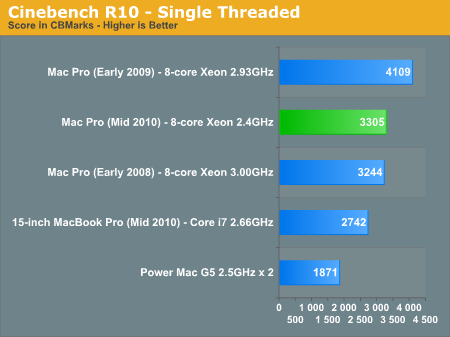
I also threw in the dual processor Power Mac G5 2.5GHz to put things in perspective. While a highly configured Mac Pro from 2008 may not be in need of an upgrade, if you’re still doing work on a Power Mac G5 an upgrade would be very appreciated. Westmere is 76% faster than the 2.5GHz G5 in this single threaded test.
Multithreaded performance scales very well on Nehalem and Westmere as you can see below:

The key takeaway here is that if you had a high clocked, eight-core Mac Pro from 2008 you can’t get away with the new 2.4GHz eight-core. The extra threads help but you need clock speed as well to manage a significant performance advantage over what you’re upgrading from.
The G5 comparison is even more ridiculous when we look at multithreaded performance. A single Westmere core running at 2.4GHz is nearly as fast as two 2.5GHz PowerPC 970FXes in Cinebench R10’s multithreaded test.
We see a similar story if we look at Cinebench 11.5 results:
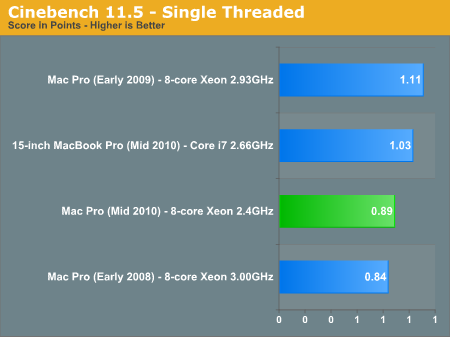
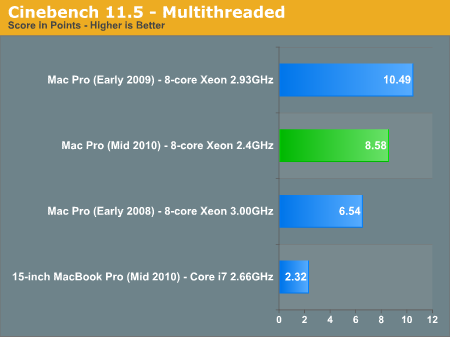
The newer benchmark is less bound by the performance of a single thread and thus we see it favoring the 2-threads-per-core you get from Nehalem/Westmere. In this case the 2.4GHz $3499 eight-core Mac Pro is faster than the 3.0GHz eight-core Mac Pro from 2008.
Remember that until Sandy Bridge, the L3 cache is the means of core-to-core communication in Intel’s Core series of processors. There was no single large shared cache in the 2006 - 2008 Mac Pro (each set of 2 cores shared an L2 cache) which is the reason for the relatively poor scaling there. Westmere gives you a larger L3 to play with and thus we see slightly better scaling from one to 16 threads vs. Nehalem. The size of the L3 cache in Westmere means that you can store more data shared by all of the cores in these heavily threaded applications.
Adobe Photoshop CS4 Performance
Photoshop is one of those benchmarks that really stresses everything. You get decent memory and I/O dependency and good use of multiple cores (but diminishing returns beyond 6 - 8 threads).
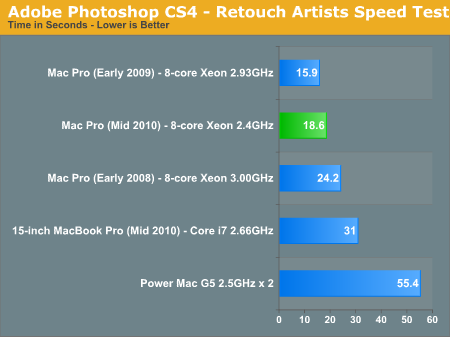
We’ve already shown the new Mac mini is nearly as fast as the Power Mac G5 in Photoshop, but the new Mac Pro cuts our test time in less than half compared to the old G5. The Westmere advantage is not tremendous here, some higher clocked Nehalems do better in this test.
Even the 2008 Mac Pro does well here, at least compared to the G5.
Aperture 2 RAW Import Performance
For my Aperture test I simply timed how long it took to import 203 12MP RAW images into the library.
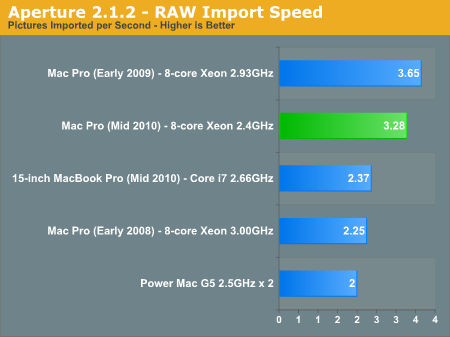
The 2009/2010 Mac Pros are very fast even in general use tasks like importing images into Aperture.
H.264 High Profile Transcoding
I have a feeling the transcoding game is going to get a lot more complicated after Sandy Bridge hits next year, but until then we’ve got our typical H.264 encoding tests. Here I’m taking a 90Mbps H.264 source file and transcoding it using Handbrake and the default High Profile settings.
The transcoding process peaks at about 11 threads, so there is an advantage to the Hyper Threading enabled systems but it’s not much. The sub-max thread count allows even the older 2008 Mac Pro to outpace the newcomer simply because of the system’s higher clocked CPUs in this case:
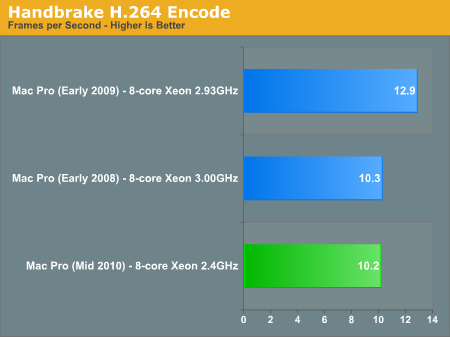
Clock for clock there is at least a 25% increase in performance over the old Mac Pro given the same number of cores. I wouldn’t expect a huge improvement vs. Nehalem at the same clock speed however.










84 Comments
View All Comments
Stuka87 - Thursday, October 7, 2010 - link
Uhm, this is the first Apple System they have reviewed in quite some time. If you click under systems up top, you will see pages of PC's, along with a review for the current gen Mac Mini last spring, and a MacBook Pro review. And there is an iPhone 4 review and AppleTV review. But these are pieces of tech that people like. Just like the 500 PC reviews and other misc. hardware.Anand Lal Shimpi - Thursday, October 7, 2010 - link
Apple gets equal treatment along with the rest of the stuff we review around here. In fact, the Mac Pro review got pushed back for months to accommodate more pressing things like the Sandy Bridge performance piece, the associated architecture article and testing for the next SSD piece.There have been a lot of Apple related articles lately but that's simply because Apple recently announced a lot. This clears out the last of the backlog. Next on the list are SSDs, HDDs and some other unmentionables... :-P
I appreciate you visiting frequently :)
Take care,
Anand
shambla - Thursday, October 7, 2010 - link
I am considering picking up an entry level Mac Pro, but I am a little concerned about future upgrade options. I understand that the daughter board in the uniprocessor model is different from that in the DP models, but is the main logic board identical to that in the dual processor Mac Pro models?More importantly, will the daughter board in the 2.8GHz Nehalem uniprocessor model allow me to upgrade to ANY of the uniprocessor variant Westmere CPUs sometime down the line, or am I restricted to Nehalem Xeons? Could I for example put in a single W3680 3.33GHz 6-core Westmere CPU in a year or two? I know that Apple offer this CPU as a build-to-order option for the uniprocessor Mac Pro, but does this require them to use a different daughter board?
Nadav2010MP - Friday, October 8, 2010 - link
Hello Shambla,In answer to your question, the main logic board(backplane board) has only one firmware version for both single and dual set ups. The firmware for the 2010 is: MP51.007F.B00 and the SMC firmware is 1.39/f11 for both the logic board and processor boards(single and dual), so yes the main backplane board's firmware is for both the single and dual.
As far as being able to upgrade to any westmere cpu, the answer is YES. For instance, when I did my upgrade by removing the 09 parts from my 09 mac pro and replacing them with 2010, the processor board already has the B1 stepping support built in, along with the D0 nehalem stepping so that you can upgrade the w3530 2.8 to a w3680... The same can be said for me.. I have a w3580 3.33 4-core DO Nehalem processor, and I can easily use the Westmere 6-core w3680 as a drop in replacement - the board's firmware accepts both Nehalem and Westmere cpus.
There is only one part number for the single-processor board. It wouldn't make sense for Apple do deny customers the right to upgrade to the w3680 later on, since the firmware supports both D0 AND B1.. Here are the part numbers:
Single-processor board: 661-5707
Backplane board: 661-5706
Dual-processor board: 661-5708
***THE DUAL WOULDN'T MAKE ANY SENSE AND I WILL TELL YOU WHY. Unlike the single-quad core which you would have, the same heatsink also works on the 6-core w3680(that same heatsink also is the same on the 2009 mac pro).. Why the dual option doesn't work is because not only do you have to get the dual board, but you also have to BUY the dual cpu heatsinks which alone would cost close to 400.00. Then the processors themselves are EXTREMELY EXPENSIVE..
The single-quad upgrade makes sense as the processors aren't too bad.. For me, who had a 2009 originally, for 300 dollars I was able to buy just the backplane board and processor board - while using my existing 09 parts(fans, case, heatsink etc..). In essence, my w3580 works great in the 661-5707 board and rightfully so because it doesn't make sense to just limit the firmware to support only 2.8,3.2 and 3.33 6-core... rather, the firmware supports all, and I MEAN ALL D0 and B1 stepping processors.. Here is my system profiler:
Model Name: Mac Pro
Model Identifier: MacPro5,1
Processor Name: Quad-Core Intel Xeon
Processor Speed: 3,33 GHz
Number Of Processors: 1
Total Number Of Cores: 4
L2 Cache (per core): 256 KB
L3 Cache: 8 MB
Memory: 6 GB
Processor Interconnect Speed: 6.4 GT/s
Boot ROM Version: MP51.007F.B00
SMC Version (system): 1.39f11
SMC Version (processor tray): 1.39f11
As you can see, the changes in firmware are visible here.. MP51.007F.B00 and SMC 1.39F11 for both backplane and processor board.. and originally my parts were 09 parts.. And yes, I am using the w3580 processor - the 2009 lineup's top of the line in the 2010 processor board, and as you can see it fully works as if it were a 2009... But, I also have the capability to use 1333 mhz memory with it since the w3580 supports 1333 along with its other brother the w3680.
shambla - Sunday, October 10, 2010 - link
Many thanks for the thorough reply - I assumed I would be fine to just drop a single 4 or 6 core Westmere into the standard uniprocessor daughterboard, since as you said, it makes no sense for Apple to use 2 parts when one is sufficient and I assumed that the Nehalem and Westmere CPUs would be similar enough that there would be no technical reason why this would not be possible. I completely agree that trying to upgrade the uniprocessor model to a dual processor system would be prohibitively expensive, given the additional parts I would require, hence my interest in using one of the 6-core Westmere CPUs instead. Thanks again for the helpHighjnx - Thursday, December 16, 2010 - link
Out of curiosity where are you able to find the backplane and processor boards for the 2010 at $300. I'm not finding either one for less than $450 = $900 US Dollars.Also I've got half a dozen X5670 chips in hand and would be curious to know if one of those would work on the single board in place of the W3680.
Any input is appreciated.
DominionSeraph - Sunday, October 10, 2010 - link
Why would you get the base Mac Pro? You can get a 980X with 24GB and SLI'd 1GB GTX 460's for ~$100 less than the Mac Pro's quad core, 3GB, and 5770.shambla - Sunday, October 10, 2010 - link
Well for a start I get educational discount which knocks something like 15% off the list price straight away. I can get the base model for just over £1600 or get it upgraded to 6GB plus swap the 5770 for the 5870 for just under £2000. I have priced up broadly similar systems using both i7 and Xeon CPUs, but in the UK, last time I checked the 980X CPU alone would cost me around £750, the pair of 460s would be around £350 and 24Gb of tri-channel RAM would be around £450. That's £1550 before I have added a suitable motherboard, PSU, case, storage etc. Plus I like OS X, it's as simple as that. Finally, if I want to free up some cash a couple of years down the line, a Mac Pro, like most other Apple systems, maintains value like no other system you can buy or build yourself.pr0nstar69 - Thursday, October 7, 2010 - link
Somebody already mentioned this in passing, but there is another horrible mistake in the price comparison: the Dell comes with a 3 Year warranty and support, as well as NBD exchanges, whereas the basic price for the Mac Pro only includes one year of warranty and support, as well as the pleasure of carrying your Mac Pro to an Apple Store.If you want to compare apples with apples, you have to at the very least add AppleCare to the Mac Pro, $249 extra. So the total "Apple tax" is more like $574, when warranty and the graphics card are taken into account.
I don't think that falls into "minimal". Especially because you'd have to be an idiot to buy a Dell workstation at the list price on the Dell website. One call to sales or to your own Dell representative should give you at the very least a few percent off, and for companies that buy Dell equipment regularly more like tens of percent.
Anand Lal Shimpi - Thursday, October 7, 2010 - link
Very true, I've updated the cost comparison to equalize along warranty as well.Both Apple and Dell can offer significant discounts if you have a relationship with them. Going through Apple's Business representatives can easily save 3 - 10% off pretty much anything. I've kept discounts out of the equation simply because they are hard to track and do vary based on a number of factors.
Take care,
Anand